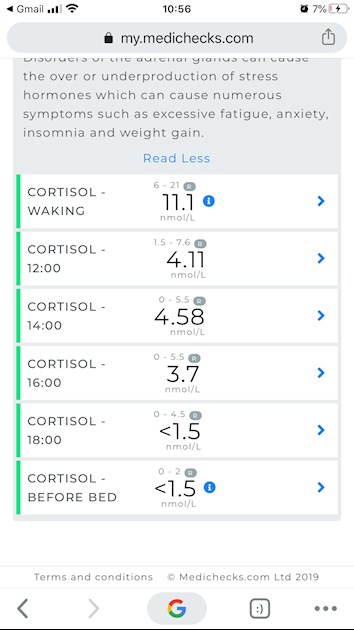Iam addressing now rt3 issues .my rt3 was 15 which is pretty high as bottom range should be 10. I was on 2 grains of nDT and experienced hypo symptoms specially headache migraines pain on my base of my head eye ball socket pain muscle pain constipation etc. So I decided to give a go to decrease NDt and add t3.my cortisol levels are fine but little lower side in the morning but still in range . I have decreased 1 grain of ndt and added 5mcg and 5mcg t3 for a week and today added another t3 and will add 5mcg t3 every week and see if I feel better. It’s my second week now since I did these changes .i wanted to ask you those people who dealt with rt3 and added t3 slowly to their ndt and decreased ndt by 1grain or so how long it took for you to get optimal? I feel more hypothyroid now is this normal while levels are getting better ? Should I feel worse before I get better and have to be patient with t3? Please I need advice anyone ! 😢please have a loook at my 6 point saliva cortisol test results are they ok ?
Addressing rt3 issues + cortisol : Iam addressing... - Thyroid UK
Addressing rt3 issues + cortisol

The two excerpts below is by an Expert who was a scientist and researcher and also an expert in thyroid hormones:-
" This is from Dr. Lowe:
1, "Under normal conditions, cells continually convert about 40% of T4 to T3. They convert about 60% of T4 to reverse-T3. Hour-by-hour, conversion of T4 continues with slight shifts in the percentage of T4 converted to T3 and reverse-T3. Under normal conditions, the body eliminates reverse-T3 rapidly."
2."Dr. Lowe: Some readers will not be familiar with reverse-T3, and I know from experience that many others harbor misconceptions about the molecule. Because of this, I have summarized in the box below what we know about reverse-T3. I've answered your question below the summary.
Conversion of T4 to T3 and Reverse-T3: A Summary
The thyroid gland secretes mostly T4 and very little T3. Most of the T3 that drives cell metabolism is produced by action of the enzyme named 5'-deiodinase, which converts T4 to T3. (We pronounce the "5'-" as "five-prime.")
Without this conversion of T4 to T3, cells have too little T3 to maintain normal metabolism; metabolism then slows down. T3, therefore, is the metabolically active thyroid hormone. For the most part, T4 is metabolically inactive. T4 "drives" metabolism only after the deiodinase enzyme converts it to T3.
Another enzyme called 5-deiodinase continually converts some T4 to reverse-T3. Reverse-T3 does not stimulate metabolism. It is produced as a way to help clear some T4 from the body.
Under normal conditions, cells continually convert about 40% of T4 to T3. They convert about 60% of T4 to reverse-T3. Hour-by-hour, conversion of T4 continues with slight shifts in the percentage of T4 converted to T3 and reverse-T3. Under normal conditions, the body eliminates reverse-T3 rapidly. Other enzymes quickly convert reverse-T3 to T2 and T2 to T1, and the body eliminates these molecules within roughly 24-hours. (The process of deiodination in the body is a bit more complicated than I can explain in this short summary.) The point is that the process of deiodination is dynamic and constantly changing, depending on the body's needs."
rT3 is not an issue. It is a safety valve. It is natures way of making sure your FT3 does not get too high.
There are many, many things that cause high rT3, like low-calorie diets, a virus, long-term beta-blocker taking, high cortisol, low iron, etc. etc. etc. And only one of them has anything to do with thyroid. And, that is if your FT4 is too high. As you have been taking NDT, it's rather unlikely that your FT4 was high enough to convert to excess rT3. But, if it were, the solution would be to reduce FT4 levels. Taking high doses of T3 is not in anyway way, shape or form, a 'cure' for high rT3.
In any case, rT3 is not any sort of problem. It does not block T3 receptors and was previously thought, it has its own receptors. It is inert, so doesn't cause symptoms, and is only in the system for about a couple of hours before it is converted to T2.
Increasing your T3 every week is not increasing slowly. It's too fast. You should only increase by 5 mcg every two weeks. And, after every four increases, hold for six weeks and retest. It is very easy to miss your sweet-spot if you go too fast. 